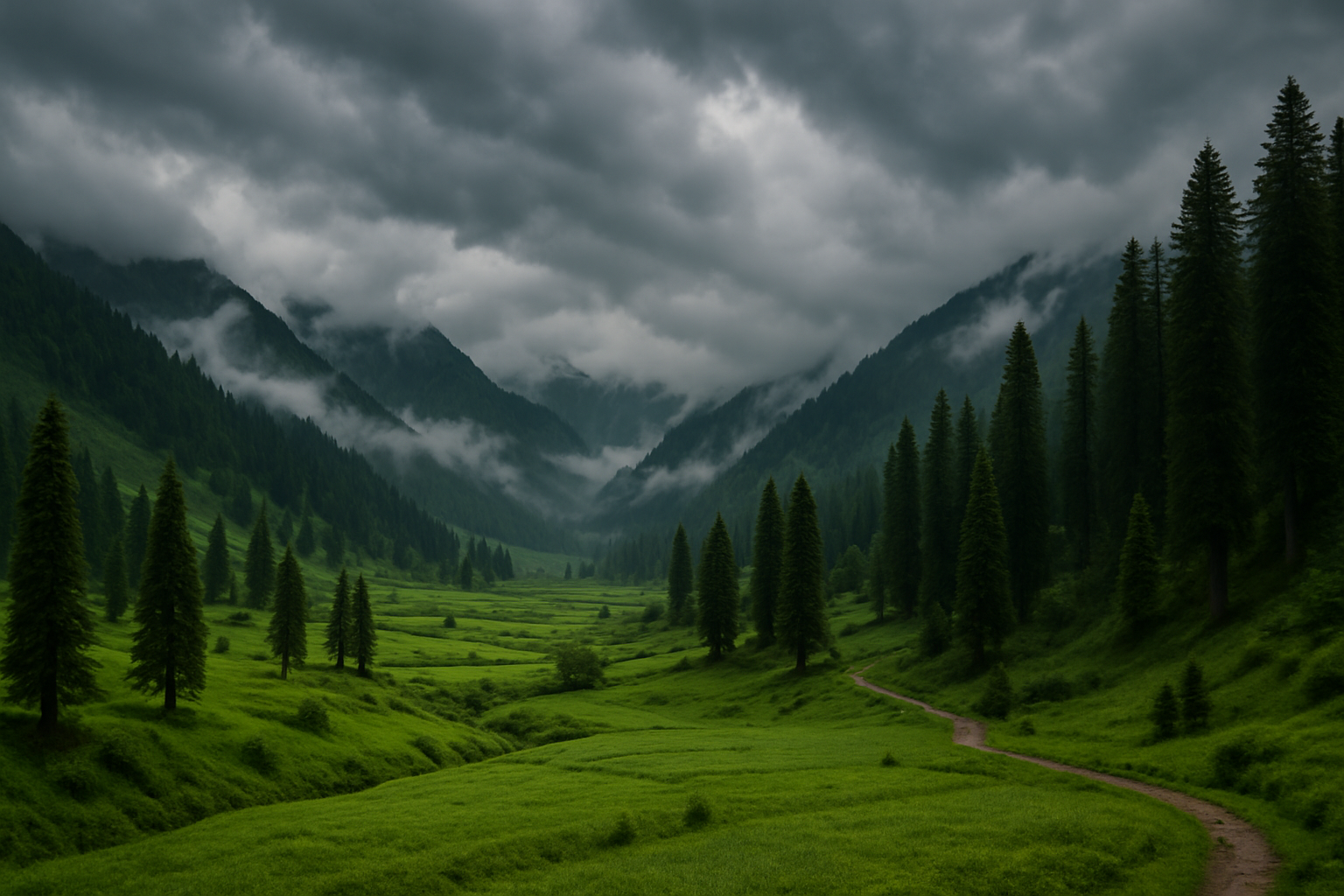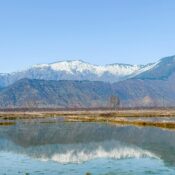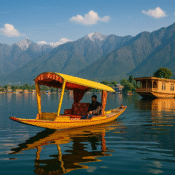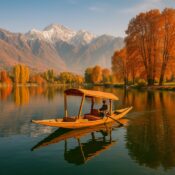
Monsoon Magic in Kashmir: Lush Valleys, Rainy Bliss & Off-Season Travel Guide
Kashmir is often celebrated for its snow‑draped winters and springtime blossoms, but there’s a secret season that few travellers truly experience. From late June to September the valley slips into a monsoon rhythm – intermittent showers paint the meadows emerald, mist curls around the Pir Panjal and Zabarwan ranges, and the Dal and Nigeen lakes gleam under rain‑washed skies. Temperatures range from a pleasant 15 °C to 30 °C, cooling the summer heat and making outdoor adventures comfortable【901645437791389†L165-L180】. Best of all, this is the off‑season – crowds thin out, and hotels, flights and tour packages are more affordable【901645437791389†L165-L180】. If you’ve ever dreamed of having Kashmir’s ethereal beauty almost to yourself, monsoon magic awaits.
Why visit Kashmir during the monsoon?
- Lush landscapes & apple harvests: Continuous sunshine breaks into gentle showers, turning valleys into carpets of mossy greens and wildflowers. In August apple orchards around Sopore and Pulwama burst with fruit, and visitors can join locals for picking sessions【901645437791389†L165-L180】.
- Off‑season bargains: Because most travellers visit in summer and winter, monsoon months are considered “off‑season”. Expect discounted rates on houseboats, hotels and flights【901645437791389†L165-L180】 and more personalised service.
- Less crowd & authentic experiences: With fewer tourists around you’ll have the Mughal gardens, shrines and bazaars largely to yourself. Even popular spots like Dal Lake and Gulmarg feel serene.
- Accessible despite showers: Rainfall is generally mild, occurring mostly in July and August. Roads remain open, and the region is still accessible and beautiful【935175525997744†L120-L125】.
5‑Day off‑season itinerary
Day 1 – Srinagar’s lakes & gardens: Begin in Srinagar with a stroll through the Mughal gardens – Shalimar Bagh, Nishat Bagh and Chashme Shahi – where rain‑kissed chinar trees and flowerbeds exude fresh fragrances. Wander the old city lanes to see wooden mosques and vibrant markets. In the evening board a decorated shikara for a cruise across Dal or Nigeen Lake; these lakes are called the “jewel in the crown” of Kashmir and are divided into sections like Gagribal, Lokut Dal and Bod Dal【51898630258419†L24-L84】. Glide past floating gardens and markets selling saffron and handicrafts, and watch the sunset over the mountains. Stay overnight in a cosy houseboat.
Day 2 – Gulmarg’s meadows & gondola: After breakfast drive to Gulmarg (“meadow of flowers”). During the monsoon the grassy slopes explode with greenery and wildflowers. Ride the Gulmarg Gondola – one of the world’s highest cable cars – to Kongdoori and Apharwat to enjoy panoramic views. Families can try pony rides or simply picnic in the meadows, while adventure seekers can mountain bike or trek to Alpather Lake.
Day 3 – Pahalgam & the Lidder Valley: Travel along the NH1A to Pahalgam, passing saffron fields and the ruins of Awantipora. In Pahalgam stroll along the Lidder river, explore Betaab and Aru valleys, or go white‑water rafting. Wateen Travels notes that Pahalgam’s rivers and adventure sports make it a family favourite【185565646345075†L85-L125】. Horseback rides to Baisaran (Mini‑Switzerland) are also popular. Spend the night in Pahalgam or return to Srinagar.
Day 4 – Sonamarg & Thajiwas Glacier: Drive through villages and forests to Sonamarg (“meadow of gold”). Hire a pony or trek to Thajiwas Glacier to admire ice‑blue rivers and waterfalls cascading down granite cliffs. Check road conditions in advance as occasional landslides can occur during heavy rain. Alternatively, bird lovers can visit Dachigam National Park near Srinagar to spot the endangered Hangul deer and black bear.
Day 5 – Yusmarg / Doodhpathri & orchard visits: For an offbeat finale, head to Yusmarg or Doodhpathri – alpine meadows ringed by pine forests that receive few visitors【185565646345075†L85-L125】. Stop at a local orchard to pick crisp apples if visiting in August or early September. Return to Srinagar and spend your evening shopping for papier‑mâché artefacts, pashmina shawls and dry fruits in the old bazaars.
Cultural highlights & must‑try foods
Kashmiri culture is intimately tied to its cuisine. The celebrated Wazwan feast can feature up to 36 dishes【143794467311320†L241-L326】. Signature dishes include Tabak Maaz – lamb ribs simmered in milk then fried in ghee; Seekh Kebab – spiced minced‑mutton skewers; Rista – meatballs in a fiery red gravy; Rogan Josh, a slow‑cooked mutton curry infused with Kashmiri red chillies; Gushtaba, tender minced‑mutton dumplings in a creamy yogurt gravy; Aab Gosh, lamb ribs cooked in milk and saffron; and Waza Chaman, a paneer dish for vegetarians【143794467311320†L241-L326】. Meals finish with accompaniments like walnut chutney, pickles, curd and phirni dessert.
Street foods are equally tempting: munch on Nadroo Monje (crispy lotus stem fritters), Seekh Kebabs, Noon Chai (salty pink tea) with Bakarkhani bread, or warm up with Harissa and grilled trout【185565646345075†L56-L70】. Wash it all down with Kahwa, a fragrant green tea brewed with saffron and spices. Don’t forget to witness local artisans weaving carpets, carving walnut wood and painting papier‑mâché; these crafts make perfect souvenirs.
Travel tips for a safe & comfortable monsoon trip
- Safety & security: Tourist areas in Kashmir are guarded by army personnel and are considered safe; however, avoid wandering alone late at night【814805362074666†L71-L161】.
- Stay connected: Prepaid SIM cards from other Indian states do not work in Kashmir. Carry a postpaid SIM or purchase a local BSNL or Airtel SIM on arrival【814805362074666†L167-L214】.
- Carry cash: Mobile connectivity can be patchy, so digital payments may not always work; carry sufficient cash【814805362074666†L167-L214】.
- Pack for rain: Bring waterproof jackets, a sturdy umbrella, quick‑dry clothing and waterproof shoes. Landslides can delay journeys, so maintain buffer days and check weather updates.
- Avoid peak pilgrimage: The Amarnath Yatra takes place from 1 July to 31 August, resulting in heavy checkpoints and limited accommodation【814805362074666†L167-L214】. Plan around these dates if you prefer peaceful travel.
- Respect local culture: Dress modestly, especially when visiting shrines. Remove shoes before entering religious sites and ask before photographing locals.
Must‑visit spots & experiences
- Dal & Nigeen Lakes: Cruise on a shikara through the lake’s different sections – Gagribal, Lokut Dal, Bod Dal and Nagin – to see floating gardens (rads) where locals cultivate vegetables and flowers. Early morning and late evening rides between April and October are particularly magical【51898630258419†L24-L84】. Spend a night on a traditional wooden houseboat.
- Gulmarg: Ride the Gulmarg Gondola, picnic on wildflower‑studded meadows and try mountain biking or trekking to Alpather Lake.
- Pahalgam: Explore Betaab, Aru and Baisaran valleys; go rafting on the Lidder; enjoy pony rides.
- Sonamarg: Trek to Thajiwas Glacier and admire alpine scenery.
- Yusmarg, Doodhpathri or Gurez: Discover offbeat meadows and small villages with warm hospitality. Gurez Valley – accessible in summer and early autumn – offers turquoise rivers and wooden hamlets.
- Dachigam National Park: Observe rare wildlife like the Hangul deer and Himalayan black bear; ideal for birdwatchers.
Book your monsoon adventure with us
Travelling during the rainy season requires careful planning – and that’s where we come in. Travel Execute crafts personalised monsoon itineraries for families, honeymooners, solo travellers and thrill‑seekers. We arrange comfortable stays – whether you prefer luxury hotels, cosy homestays or romantic houseboats – private transport, knowledgeable local guides and activities tailored to your interests. Because monsoon is off‑season, our packages offer excellent value and flexibility.
Ready to experience Kashmir’s rainy bliss?
Plan your off‑season getaway today! Reach out via email at info@travelexecute.com or drop by our office in Srinagar, Kashmir. To chat instantly, click the WhatsApp button below and let’s start planning your dream trip.




